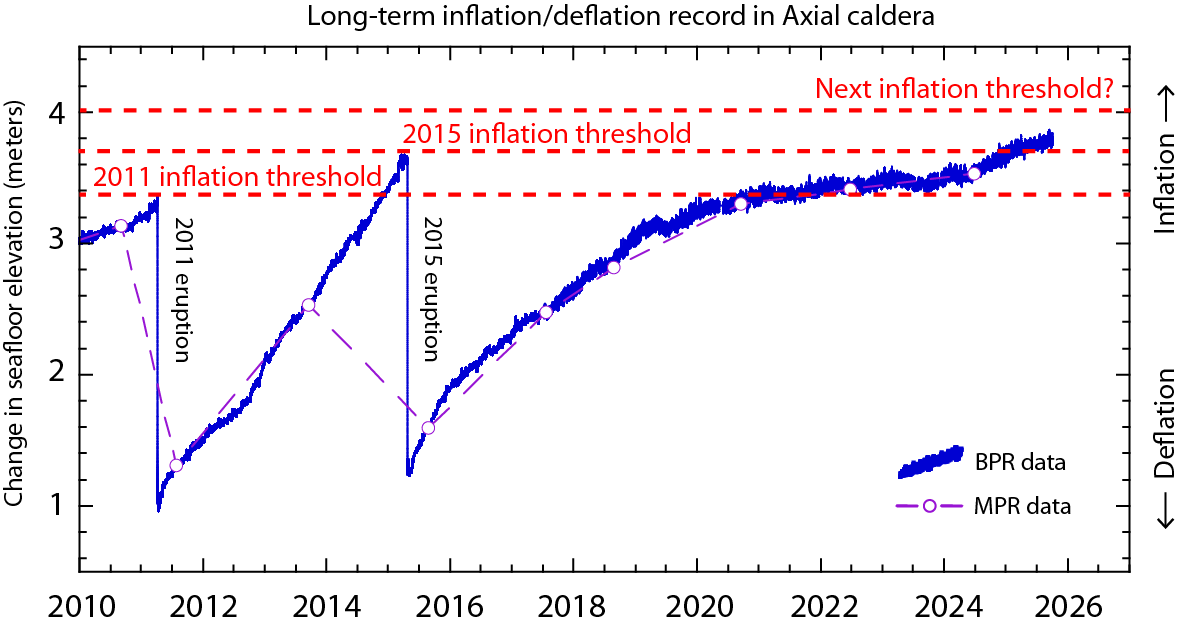An undersea volcano off the Oregon coast could explode in mid-to-late 2026, scientists say.
Last December, scientists said Axial Seamount was approaching the threshold seen before its eruption a decade earlier. may flare up within a year. They now predict that the eruption will likely occur later than previously expected, in mid-to-late 2026.
“After successfully forecasting the Axial Volcano eruption in 2015, we have been trying to predict the next one ever since,” Bill ChadwickProfessor of Geology and Geophysics at Oregon State University, Co-Director blog about seamounttold Live Science in an email.
IN presentation Speaking to the American Geophysical Union in December 2024, Chadwick and colleagues said the eruptions at Axial Seamount follow a period of high seismicity and sustained ground inflation caused by magma rising beneath the seafloor. The last three eruptions occurred at the same, albeit slightly increasing, inflation rate, so the volcano is likely to erupt again once it reaches or exceeds this threshold, they say.
After the 2015 eruption, inflation below the seamount began to rise again. But the inflation rate fell gradually through 2023, and “by the summer of 2023 the growth rate was almost zero,” Chadwick noted in an abstract for a presentation he wrote in July 2024.
Then, in the fall of 2023, rates of inflation and seismicity increased again, indicating “a fundamental change in the supply of magma to the volcano,” Chadwick wrote in the abstract. “Based on current trends and the assumption that Axial will be ready to erupt when it reaches the 2015 inflation threshold, our current eruption forecast window is between now (July 2024) and the end of 2025,” he wrote.
By the end of 2024, Axial's inflation rate had reached 95% of the level before the 2015 eruption.
But by the end of April 2025, inflation rates had slowed again, and on October 27, Chadwick updated the Axial blog, saying it was time to revise the December 2024 forecast. “It will take a little longer than we expected to reach the same inflation threshold that the volcano reached before its last eruption,” he wrote. “At current inflation rates, we will not reach a higher inflation threshold until mid-to-late 2026.”
The Axial Seamount behaves similarly to Iceland's Krafla volcano, where the rate of inflation required to erupt increases slightly with each eruption, Chadwick told Live Science. The inflation threshold in 2015 was about 12 inches (30 centimeters) higher than in 2011, so scientists expect a similar increase in rise will be seen now before another eruption occurs, he said.
The ground is currently 4 inches (10 cm) higher than it was minutes before the 2015 eruption, with potentially another 8 inches (20 cm) remaining until the next eruption. “It's really just an educated guess, but it's also based on the previous behavior of volcanoes like Krafla,” Chadwick said.

The reason for this increase in inflation with each eruption may be that magma rising to the surface compresses the surrounding crust, making it harder for the magma to rise again in the same place years later, Chadwick said. But inflation thresholds won't rise indefinitely because the Juan de Fuca Ridge releases compressive stress in the Earth's crust as it spreads, he added.
Inflation rates and thresholds are unpredictable, making it difficult to estimate the timing of the eruption. “The forecasting efforts described in the blog are based on simply recognizing patterns in past monitoring and guessing how that might happen in the future,” Chadwick said.
However, a new wave of physics-based models may make this process easier: model What Chadwick and his colleagues are working on could be used to use previous monitoring data to accurately predict past eruptions, he said.
Starting this week (November 10), researchers will use the model to analyze real-time data from the Axial seamount and try to predict its next eruption, Chadwick said. The results won't be published until the next eruption because that's the only way to demonstrate the model's success or failure, he said.








